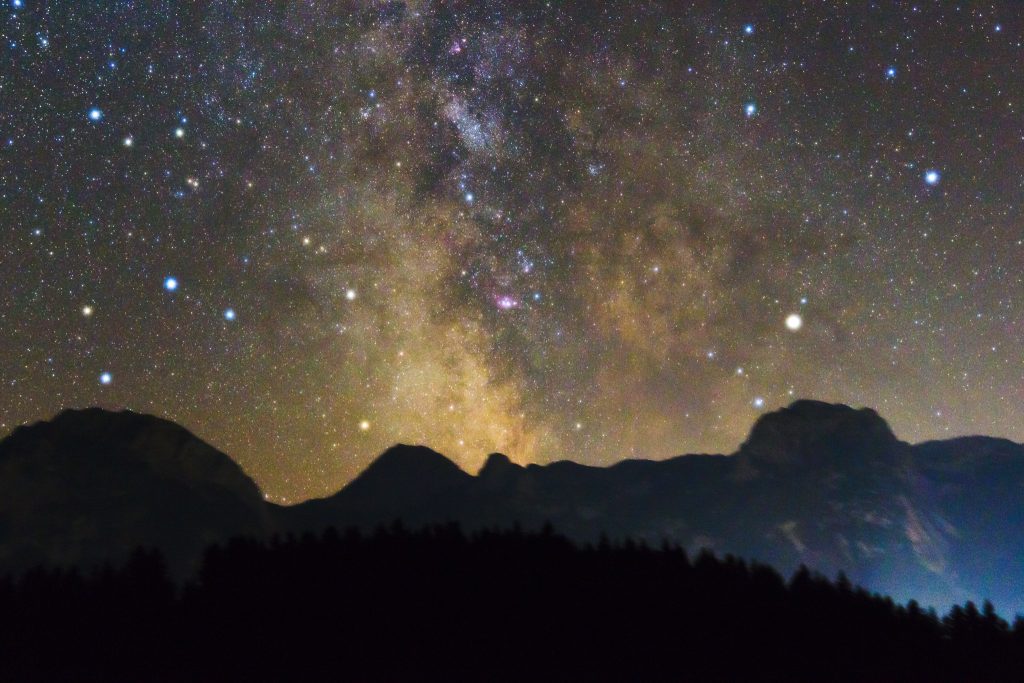Saturn takes center stage once darkness falls in October. Although the ringed world reached opposition and peak visibility in late September, the view this month is almost as good. The magnitude 0.7 planet lies in the northeastern corner of Aquarius the Water-bearer and appears far brighter than any nearby star. This area climbs highest in the north in late evening.
Saturn’s icy rings always bring a thrill to backyard observers. Yet the excitement is muted a bit in October because the rings appear nearly edge-on. They tilt 1.5° to our line of sight on the 1st and just 0.6° on the 31st. With the rings creating less distraction, look for subtle atmospheric detail on the planet itself. Saturn’s moons also become easier to spot with the reduced glare from the rings. Titan shows up through any telescope, while Tethys, Dione, and Rhea emerge in a good 10cm instrument.
As the month progresses, you can watch Mercury and Mars dance low in the western evening sky. Mars makes its final evening stand in October as it sinks deeper into twilight. The ruddy world appears only 4″ across through a telescope, too small to show any detail.
The Red Planet’s main interest this month is its approach to Mercury. The innermost planet becomes visible in early October and climbs into a darker sky as the month progresses. On the 19th, the two worlds stand side by side with just 2° separating them. Magnitude –0.2 Mercury lies to the left of its magnitude 1.5 sister world. Their official conjunction arrives 2 days later.
Mercury reaches greatest elongation Oct. 29, when it stands 24° east of the Sun and appears 11° high an hour after sundown. A telescope reveals the planet’s 7″-diameter gibbous disk.
You’ll have to wait until after midnight to see Jupiter. The giant planet appears against the backdrop of eastern Gemini, above that constellation’s two brightest stars, Castor and Pollux. At magnitude –2.2, Jupiter easily outshines the stars in its vicinity.
The best views through a telescope come once the planet climbs higher with the approach of dawn. Jupiter spans 38″ at midmonth and should show significant detail in its atmosphere. Meanwhile, its four bright moons — Io, Europa, Ganymede, and Callisto, all of which Galileo discovered in 1610 — stand out in any size scope. I often find Jupiter looks best with a touch of twilight in the sky, so you might want to try that trick.
The brightest planet hangs low in the east during morning twilight. Venus shines at magnitude–3.9 but stands only 5° above the horizon 30 minutes before sunrise. The inner planet won’t look like much through a telescope. In mid-October, its disk appears 11″ in diameter and nearly full.
A waxing crescent Moon occults 1st-magnitude Antares in Scorpius on Oct. 25. People in the southern part of South America can see an 11-percent-lit Luna overtake the red supergiant star and hide it from view for nearly an hour. From Punta Arenas, Chile, the pair lies low in the west-southwest in the early evening sky. Antares disappears behind the Moon’s dark limb at 1h37m UT (locally the evening of the 24th) and reappears at 2h28m UT.
The starry sky
Pisces the Fish has always struck me as a curious constellation. Ancient skygazers developed several stories as to why a constellation with two fish even exists. Some suggest the two fish carried Eros and Aphrodite away from the danger posed by a monster called Typhon, or that Eros and Aphrodite were turned into fish themselves.
In October, the entire star group clears the northeastern horizon by midevening. Although Pisces’ stars are rather faint, the constellation is easy to find this year because it lies directly below the prominent planet Saturn, which lies in neighboring Aquarius.
The fish stand a full 30° apart in the sky. An angled cord of stars, whose mythological origin and meaning remain obscure, joins the two. The northern fish lies well north of the celestial equator, at a declination of 30°. You can find it northwest (to the left) of the trio of bright stars Alpha (α), Beta (β), and Gamma (γ) Arietis.
The southern fish resides just north of the celestial equator. This collection of 4th- and 5th-magnitude stars creates a fairly conspicuous asterism known as the Circlet. The stars Iota (ι), Theta (θ), Gamma, Kappa (κ), and Lambda (λ) Piscium form a pattern close to a regular pentagon. The shape appears more rounded when you add 7 and TX Psc.
Although the Circlet asterism lies entirely north of the equator, a small chunk of Pisces south of this asterism extends to negative declinations. The cord connecting the two fish runs eastward from the Circlet to the magnitude 3.8 star Alrescha (Alpha Psc) at the constellation’s southeastern corner. The star’s name comes from an Arabic word meaning “the cord.” A small telescope shows it to be a close binary comprising two whitish stars. A jagged line of fainter stars connects Alrescha with the northern fish.
The Circlet asterism also serves as a guide to locating the point on the sky known as the vernal equinox. This spot marks one of the two positions where the ecliptic — the apparent path of the Sun across our sky — crosses the celestial equator. The equinox lies some 5° southeast (to the lower right in October’s evening sky) of the asterism.
Star Dome
The map below portrays the sky as seen near 30° south latitude. Located inside the border are the cardinal directions and their intermediate points. To find stars, hold the map overhead and orient it so one of the labels matches the direction you’re facing. The stars above the map’s horizon now match what’s in the sky.
The all-sky map shows how the sky looks at:
10 p.m. October 1
9 p.m. October 15
8 p.m. October 31
Planets are shown at midmonth

